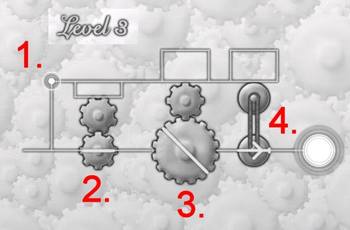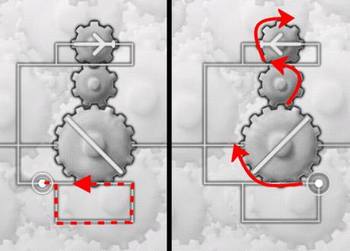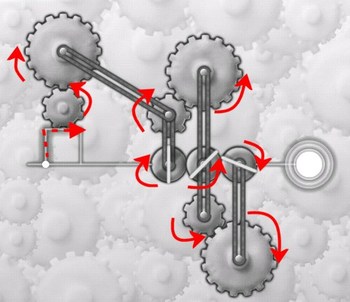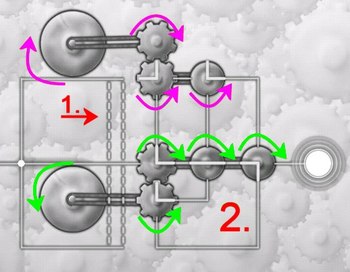Grayscale: 2 of 101
 Friday, February 12, 2010 at 11:36PM
Friday, February 12, 2010 at 11:36PM Grayscale is yet another indie puzzle game. The presentation is clean. The mouse and arrow key controls work fine. The game has just just the right amount of levels showcasing a nice variety of of challenges. Oh, and the colors are a bit lacking (that one's a a joke).
Truly, the point of puzzle mode levels like the ones in Grayscale is to test our cognitive abilities. In other words, our knowledge skills are put to the test. Reading Grayscale is a fairly deep process made up of layered, easy to understand elements. Let's take a quick look.

- You play as the little white ball near the number 1 (see image above). The first level of reading Grayscale involves seeing how the paths are arranged to determine how to get the white ball to the goal. The goal is the big glowing white area.
- To get to the end of most levels, you have to rotate gears to line up paths embedded inside the gears. Some gears have straight paths inside, others have right angle turns, and others have one way paths embedded.
- There are small and large gears/wheels. By moving against the gears you can rotate them. Fortunately, the rotation of the gears/wheels are quantified to greatly simplify things. Move past any gear/wheel and you rotate it a quarter turn.
- Things get more complicated when gears are nestled against each other. The behavior of nestled gears can be described very simply. With two nestled gears, when one turns clockwise the other turns counterclockwise and visa versa.
- When a small gear turns a big gear the amount the big gear rotates is exactly 1/8 of a full rotation. Likewise, when a big gear turns a small gear the small gear will rotate 1/2 of a full rotation.
- Pulleys complicate things a bit more. Because a pulley is attached to the shaft of a rotating gear, it allows two gears/wheels to rotate in the same direction.
- Throw in paths that disintegrate after moving over them and the reading of Grayscale becomes quite involved. (see the arrow at #1 in the image below).
In some of the later levels players have to put all of their knowledge to the test. In the example above, reading the gear/wheel rotation dynamics isn't enough. Planning around the disintegrating paths and the complex gear systems requires a deeper reading. Once you can see the level like I've diagrammed, the whole challenge becomes a simpler one. Such is the beauty of reading deeply.
The intersection of a few simple rules (emergence) makes deep readings possible. This design gives Grayscale a much higher deep:complex reading ratio compared to Continuity. Focusing on depth over complexity is probably why I had a much easier time playing through Grayscale.





Reader Comments